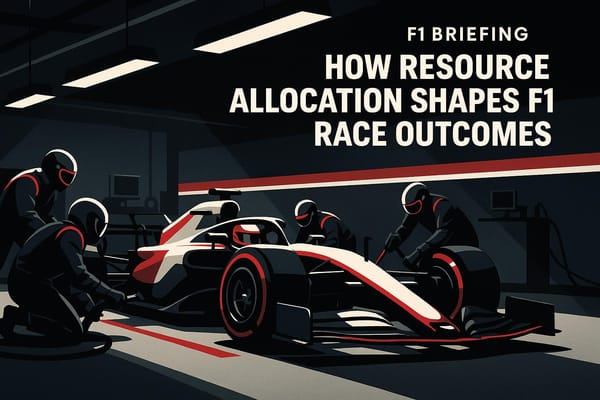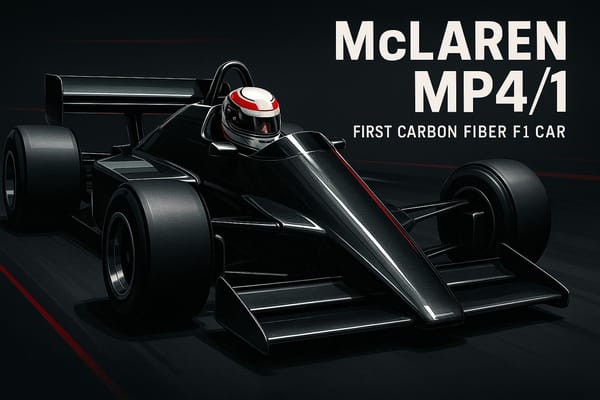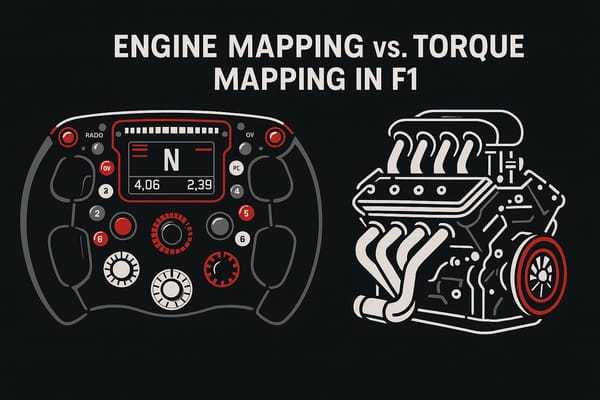How F1 Teams Use Radio for Strategy
Explore how radio communication shapes strategy in Formula 1, enabling real-time decisions and team coordination during races.
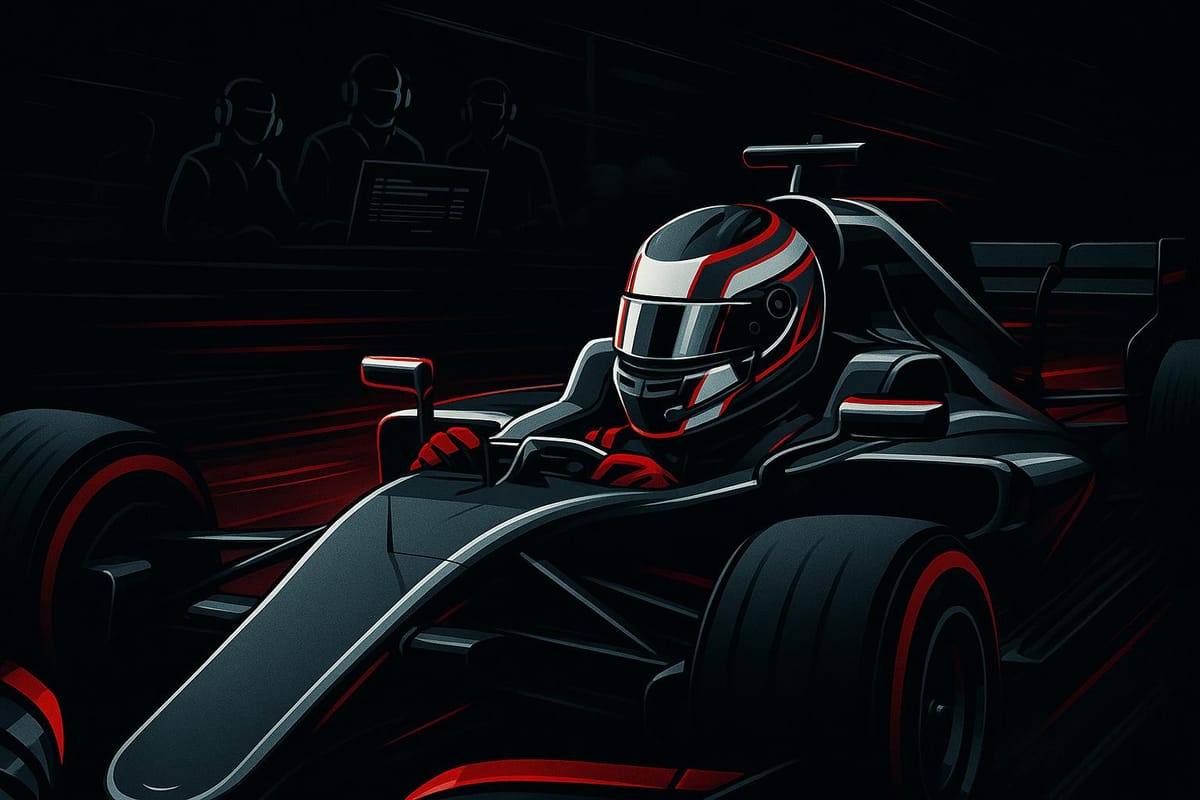
Team radio is the backbone of Formula 1 strategy. It enables split-second decisions, keeps drivers informed, and ensures teams stay ahead in unpredictable race conditions. Here's what you need to know:
- Real-Time Communication: Teams use radios to adjust strategies, manage tire wear, and respond to weather changes instantly.
- Pit Stop Coordination: Radios help execute flawless pit stops by syncing drivers, engineers, and mechanics.
- Driver Feedback: Drivers relay car performance data, helping engineers make adjustments mid-race.
- Coded Messages: Teams use codes to protect strategies from rivals, often employing misleading messages to confuse competitors.
- Technical Challenges: Radio systems can fail due to interference or extreme conditions, with teams relying on backup methods like pit boards.
Quick Overview
| Feature | Purpose | Example Use Case |
|---|---|---|
| Real-Time Updates | Adjust strategy on the fly | Switching to wet tires during rain |
| Pit Stop Coordination | Synchronize team actions | Timing a pit stop to gain track position |
| Driver Feedback | Optimize car performance | Reporting tire grip or brake issues |
| Coded Messages | Conceal strategy from rivals | "Hammer time" means push for fastest lap |
| Backup Systems | Maintain communication if radios fail | Using pit boards when radios go offline |
F1 team radios are essential for success, turning individual driving into a team effort. Without them, races would come down to guesswork instead of precision strategy.
How Do F1 Teams Communicate Over A Race Weekend? Albert Fabrega’s F1 TV Tech Demo | Crypto.com
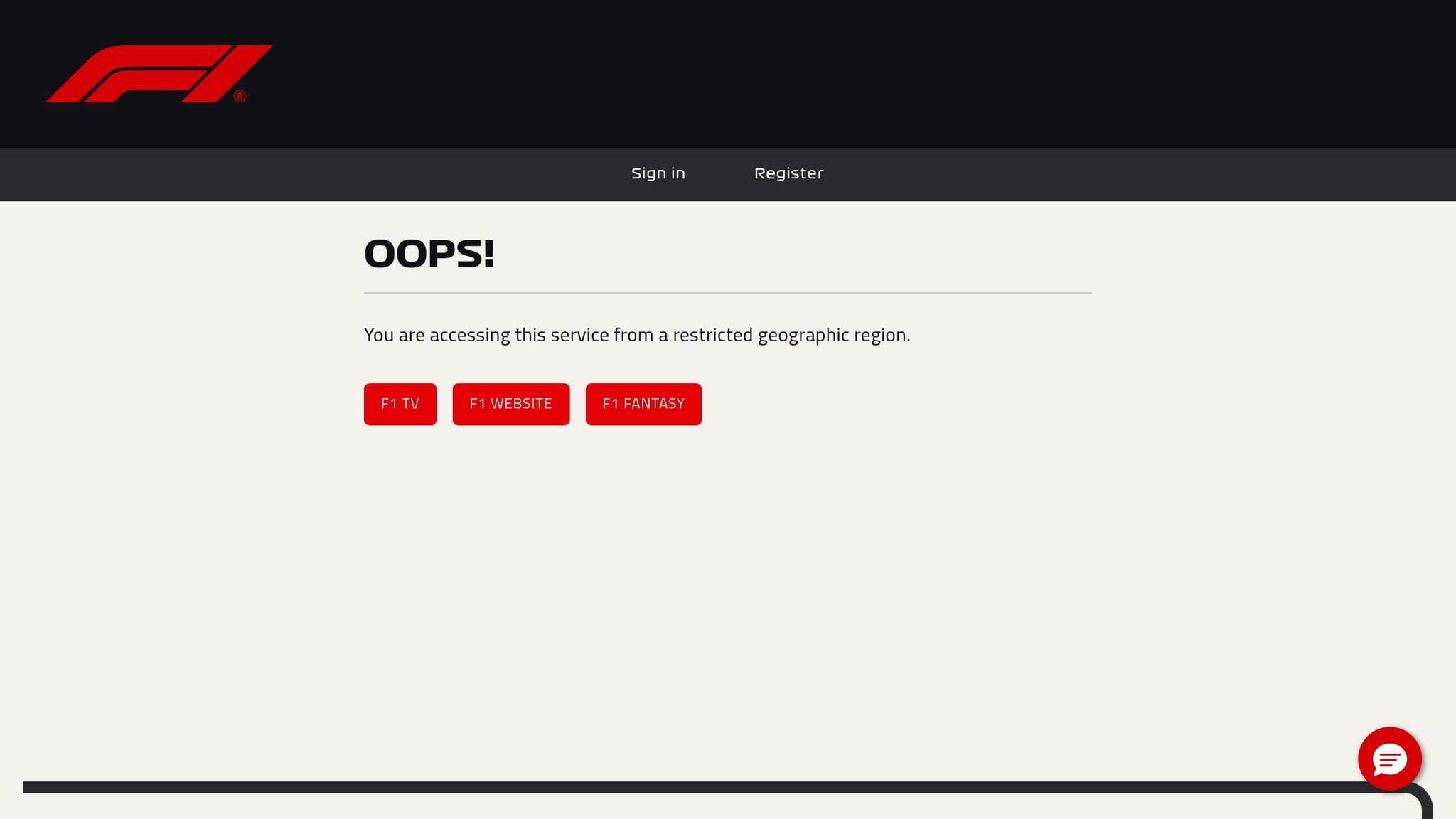
How F1 Teams Use Radio for On-Track Strategy
In Formula One, radio communication transforms individual driving into a finely-tuned team effort. It’s the critical link between the driver in the cockpit and the team on the pit wall, allowing for split-second decisions that often decide whether a car finishes on the podium or out of the points. This constant back-and-forth is the backbone of in-race strategy, helping teams adapt to the unpredictable nature of F1 racing.
Real-Time Race Adjustments
F1 races are anything but predictable. Weather changes, tire wear, and competitor moves can shift the landscape of a race in an instant. Radio communication is what allows teams to stay ahead of these challenges, making adjustments in real time.
For example, when rain threatens, teams monitor radar systems and relay critical timing decisions to their drivers. A well-timed call to switch to wet tires can secure a significant advantage over rivals who delay. Similarly, if a competitor pits unexpectedly, strategists quickly crunch the numbers and advise their driver to adjust pace or strategy. In a sport where milliseconds matter, these rapid decisions can make or break a race result.
Pit Stop Coordination
Pit stops are among the most high-pressure moments in any F1 race, and radio communication ensures they happen without a hitch. Teams use the radio to determine the perfect pit window, factoring in everything from tire wear to competitor positioning and overall race strategy.
When the race throws unexpected developments into the mix, clear and precise communication becomes even more essential. Every team member has a role, and the radio keeps everyone in sync, ensuring the operation runs like clockwork. A well-executed pit stop, guided by seamless communication, can be the difference between gaining or losing track position.
Driver Feedback and Car Management
Beyond strategic calls and pit stops, the radio serves as a two-way lifeline for ongoing car management. Drivers provide real-time feedback on everything from tire grip to brake performance, helping engineers make adjustments on the fly.
Take the 2024 Bahrain Grand Prix, for instance, when Charles Leclerc used the radio to report braking issues:
"Something felt very off on this set. The fronts were locking like crazy".
This feedback allowed Ferrari’s engineers to quickly address the brake balance problem, ensuring Leclerc could continue to push without compromising his race.
Engineers also use the radio to guide drivers through technical adjustments. During the 2022 Spanish Grand Prix, Hugh Bird suggested a brake balance tweak:
"B-bal four is available for a bit of stability".
Similarly, in the 2023 Brazilian Grand Prix sprint race, Xavier Marcos Padros recommended a differential change:
"And diff mid plus one, suggestion".
These exchanges highlight how teams fine-tune car performance during the race, responding to evolving track conditions and handling challenges. Beyond performance tweaks, the radio also serves as a tool for reminders about fuel management and tire conservation, ensuring drivers strike the right balance between speed and endurance over the course of a stint.
Coded Messages and Team Confidentiality
In Formula One, every radio message carries weight. Since all teams can listen in on each other's communications during races, strategy isn't just about speed - it's also about outsmarting opponents. To protect their plans while throwing rivals off course, teams have developed intricate systems of coded language. These coded messages have become a cornerstone of modern F1 strategy.
Common Coded Phrases
F1 teams rely on phrases that sound harmless but carry specific meanings. These codes allow them to share vital information with their drivers while keeping competitors in the dark. For instance, "Hammer time" is Lewis Hamilton's signal to go all out and set the fastest lap possible. "Box this lap" means the driver should pit at the end of the current lap, while "Li-co" - short for "lift and coast" - tells drivers to back off the throttle to conserve fuel.
To stay ahead, teams frequently update their codes. Phrases like "Mode [x]" refer to power unit settings, and "Strat [x]" adjusts energy recovery and power output. The catch? These designations change every race weekend to keep rivals guessing.
Some teams take deception even further with fake radio messages. McLaren CEO Zak Brown revealed in 2025 how his team uses misleading questions to confuse competitors. He explained:
"We ask genuine questions followed by decoy ones, since all teams can listen. It's kind of like a third base coach at a baseball game is doing all these signs, but you know when he touches his hat, the next sign counts. But until he touches his hat… so we do that verbally."
Brown provided an example:
"So if we say to Oscar, 'Oscar, how are your tyres?' That is a real question. Anything we say after tyres, if we say anything, it's a bogus question. 'Oscar, how are your tyres doing?' Bogus question. We want him to go, 'I don't think I can last much longer.' And then the other teams go, 'Oh, McLaren might be getting ready for a pit stop,' and they start building their strategy around what we're doing."
This clever misdirection turns team radio into a psychological chess match, delivering clear instructions to drivers while planting false ideas in competitors' minds. Naturally, such tactics have sparked regulatory attention.
FIA Regulations on Radio Transparency

With the rise of coded messages, the FIA has had to walk a fine line between ensuring fair play and allowing teams some room for creativity. To maintain transparency for fans and limit over-coaching of drivers, the FIA requires all team radio communications to be broadcast live, albeit with a slight delay. This has only pushed teams to craft even more creative codes.
The FIA actively monitors these communications for unusual patterns that could hint at coded instructions. Former FIA Race Director Charlie Whiting explained their approach:
"If we had some suspicion that a message is rather odd, we could look at the data from the car and see if anything has changed in response to that message. Then at the next race if we hear the same message we will look for the same switch change or something like that. We will build up a little knowledge."
The rules define what types of messages are allowed, and teams face penalties for violations. Minor infractions might earn a warning, while serious breaches that give a competitive edge can result in time penalties. However, enforcing these rules isn't always straightforward. Whiting noted:
"I can't tell you how a coded message is defined because it depends entirely upon what the message is and what the explanation for that message is. By putting down exactly what you can say, if you go outside of that it is fairly obvious."
Despite these regulations, teams continue to push the limits. A study of the 2014 Italian Grand Prix found that 36.5% of broadcast radio messages would have been banned under stricter communication rules. This shows just how deeply coded communication is embedded in the strategies of modern F1 racing.
Challenges and Limitations of F1 Radio Communication
Radio communication plays a pivotal role in modern Formula One, helping teams execute strategies with precision. However, it’s not without its flaws. From technical glitches to human errors, these challenges can disrupt even the most carefully crafted plans, forcing teams to adapt on the fly.
Technical Failures
The extreme conditions of Formula One - ranging from intense heat to electronic interference on urban circuits - can wreak havoc on radio systems. High humidity and other environmental factors often degrade signal quality, leading to interruptions or complete signal loss.
For instance, during a practice session at Imola, the entire telemetry network, including driver communications, went offline. A similar situation unfolded in Turkey, leaving teams without critical performance data or direct contact with their drivers. Otmar Szafnauer, former Aston Martin CEO, reflected on the impact of such failures:
"Until you lose that kind of data I think you don't realise how much you rely on it... It was like we were blind at the pit wall. Even driver communication wasn't working and it made things much more difficult."
Haas Team Principal Guenther Steiner also commented on the widespread nature of these issues:
"Everybody had issues... I think it was communicated quite quickly that everybody's radio wasn't working."
In these moments, teams rely on backup systems like pit boards to maintain communication.
Driver-Engineer Miscommunication
In the high-stakes world of Formula One, even a slight misunderstanding between driver and engineer can lead to costly mistakes. Under pressure, the clarity of communication becomes critical, yet it’s also when errors are most likely to occur.
A memorable example of this occurred during the 2024 Hungarian Grand Prix. Max Verstappen’s visible frustration with his team’s strategy decisions showcased how easily miscommunication can escalate during a race. As Mercedes explained:
"During the race itself, the aim of the strategy department is to optimise the car against the competition, to finish the race in the highest position possible."
Despite thorough preparations, unpredictable factors like sudden weather changes often require split-second decisions, leaving room for error.
Comparison: Radio vs. Pit Board Communication
While radio communication is the go-to method for real-time updates, pit boards continue to serve as a dependable backup. Each has its own strengths and weaknesses:
| Feature | Radio Communication | Pit Board Communication |
|---|---|---|
| Instant, two-way updates | Allows immediate feedback and adjustments | One-way communication only |
| Information Complexity | Conveys detailed strategies and instructions | Limited to basic data like lap times and positions |
| Driver Concentration | Can distract drivers during critical moments | Easier to absorb passively |
| Reliability | Prone to technical issues | Consistently dependable |
| Response Time | Enables instant reactions from drivers | Delayed, as it requires driver acknowledgment |
| Information Type | Verbal instructions and performance data | Visual cues and simple symbols |
Drivers process these communication methods differently. Radios demand active attention, which can be distracting during high-speed sections, while pit boards provide straightforward information that can be absorbed with minimal effort. For example, complex strategy updates are better suited to radio, whereas basic metrics like lap times are ideal for pit boards.
Importantly, FIA regulations ensure teams don’t use pit boards to bypass radio restrictions, keeping both methods within the sport’s rules. When radio systems fail, pit boards become indispensable, offering a reliable fallback to maintain the connection between the pit wall and the driver. This dual approach highlights the importance of having robust alternatives in the fast-paced world of Formula One.
Conclusion: The Role of Team Radio in F1 Success
From its early analog days to the sophisticated digital systems of today, team radio has become the backbone of modern Formula 1 strategy. Oracle Red Bull Racing sums it up perfectly:
"Communication in Formula One needs to be done really well and a team that doesn't communicate well, doesn't win".
A prime example of this was the 2020 Hungarian Grand Prix. During that race, Red Bull Racing orchestrated a remarkable repair operation, coordinating across six radio channels to connect Max Verstappen with his race engineer, mechanics, and the entire pit wall team. Reflecting on this, Red Bull's chief engineer Paul Monaghan highlighted the importance of trust within the team:
"If the driver trusts the team and vice versa, then we're in a position where we're not doubting one another, questioning one another. Then you're a team and fighting as one".
Beyond its impact on the track, team radio has also reshaped how fans experience the sport. By giving viewers a front-row seat to real-time strategy and decision-making, it has brought fans closer to the action, offering a deeper appreciation of the complexities behind every high-speed battle.
In a sport where fortunes and championships are on the line, one thing is clear: clear and precise communication isn’t just an advantage - it’s essential for success.
FAQs
How do F1 teams keep their radio communications secure from rival teams?
Formula 1 teams use state-of-the-art encryption technologies to keep their radio communications private. These secure systems safeguard critical details such as race strategies, tire selections, and pit stop timings from falling into the hands of rival teams.
To counter evolving security risks, teams are also looking into quantum-safe encryption - a forward-thinking approach designed to maintain the integrity of their communication systems as technology advances. This ensures their tactics remain shielded, even in the intense, high-pressure environment of competitive racing.
What technical challenges do F1 teams face with radio communication during races?
Challenges in F1 Radio Communication
F1 teams face a host of technical hurdles when it comes to radio communication during races. One major issue stems from environmental conditions - things like high humidity, extreme heat, or interference from nearby electronic systems can mess with signal clarity and reliability. When this happens, communication between drivers and the pit wall can become delayed or even incomplete.
On top of that, technical failures can wreak havoc. Faulty sensors, broken transmitters, or software glitches can lead to telemetry breakdowns, making it tough to share critical data in real time. These kinds of disruptions can throw a wrench into mid-race strategy adjustments and make it harder for drivers and teams to stay in sync during those high-pressure moments on the track.
How do F1 teams use coded radio messages to gain a strategic advantage?
In Formula 1, teams rely on coded radio messages to discuss critical race strategies while keeping their plans hidden from rivals. These messages are packed with unique jargon, abbreviations, or phrases that are only meaningful to the team. For instance, words like "migration" or "Li-co" might hint at tire strategies or adjustments to engine settings.
This coded approach is crucial because all team radio transmissions are broadcast publicly. By using these secretive codes, teams can talk about pit stops, fuel strategies, or overtaking maneuvers without tipping off competitors. It’s a clever way to maintain confidentiality and secure an edge during the intense competition of a race.

